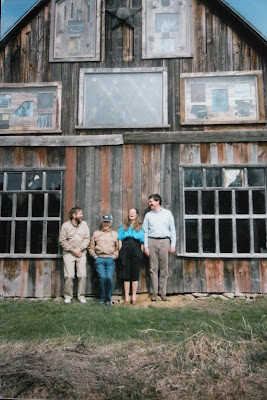Sheepdogs
on their birthday (Duffy, left, black ear; Mike, right, all-white head)
Dear George,
Our sheepdogs, Mike and
Duffy, celebrated their tenth birthday on Saturday. Like all such things, it’s hard to believe. It seems not that long ago that Katja
brought them home as little roly-poly balls of fluff. Now they’re the equivalent of age seventy in human years,
and we all live together in a senior commune of sorts.
The other day Mike and Duffy and I went on an outing to Burnet Woods, and I took some photos along the way. Here’s how these handsome, ten-year-olds are looking these days. The dogs have recently gotten their spring cuts, and they are looking very lean and boyish. People on the street frequently ask if they are puppies, and they’re surprised when I say they’re ten. Because we’re around them all the time, we see more signs of the aging process. Both dogs have to work harder to get up from lying on the floor. Mike struggles some when walking up the back porch steps. Duffy has always jumped into our high bed from a standing position, but now he occasionally misses and has to try again.
In addition, the dogs’
personalities have tended to change with age. Though still the alpha dog, Duffy has mellowed a lot. He’s less fanatical about owning all
the toys in the house and less frightened by the garbage can lids on the
sidewalk on trash pick-up day.
Mike, who’s always been subordinate, has become more assertive, even
aggressive at times. When he’s up
on the bed first, he goes crazy barking at Duffy to keep him off. Duffy, however, is not intimidated. Usually he turns his head and simply
lets Mike do his thing. Eventually
both of them will circle around and lie down, and that’s the end of the
fracas. While they used to have
physical spats every now and then which wound up with bite marks in Mike’s ear,
now it’s just some mutual growling which is macho-macho but short-lived.
Mike and Duffy go to see the
dog chiropractor in Northern Kentucky every three months, and he gave both dogs
a good report on our most recent visit.
I’m especially pleased for Mike because his X-rays at age one showed
severe hip dysplasia, and we didn’t even know if he would be around at age
ten.
The dogs, of course, continue
to be at the center of our daily lives.
They’re very human-oriented and have become more affectionate with
age. They’re both distressed when
we leave the house and are thrilled when we return. An outside observer would probably conclude that Katja and I
are pathologically enmeshed with the dogs since we exhibit practically every
stereotype of excessive American pet ownership. However, it’s hard not to be infatuated. Though we sometimes have had parties on
Mike and Duffy’s birthday, we just had a quiet day this year. They lay on the bed for five hours with
Katja, listening to the Metropolitan Opera broadcast of Wagner’s ring cycle. They looked like they might be enjoying
it, but who’s to say?
Love,
Dave
G-mail Comments
-Terry O-S (4-30): Happy Birthday to Mike and Duffy. Katja
listening to the Ring Cycle on Saturday reminded me of your Dad lying on his
bed at Farm and listening to the weekly Saturday Met broadcast. Have you
and Katja attended any of the live digital broadcasts of Met performances at
the Regal Theaters? I absolutely cannot do Wagner - but there are others
I've really enjoyed.
Terry





































































































































































































































